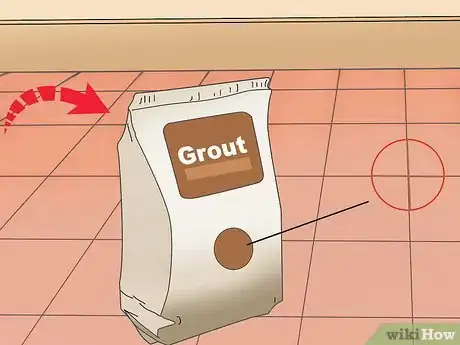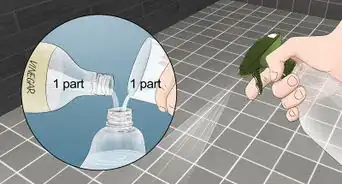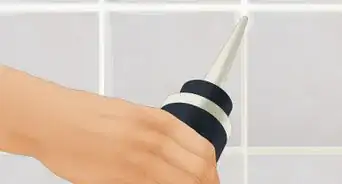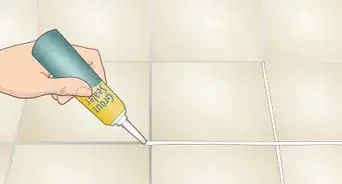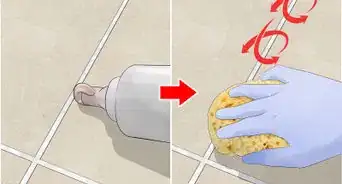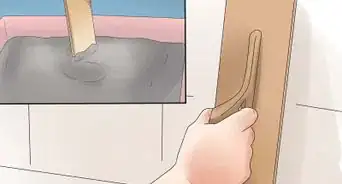This article was co-authored by Norman Raverty and by wikiHow staff writer, Kyle Hall. Norman Raverty is the owner of San Mateo Handyman, a handyman service in the San Francisco Bay Area. With over 27 years of experience, Norman has expertise in all five of the general building trades (carpentry, ceramic tile, drywall, electrical, plumbing).
This article has been viewed 48,120 times.
Grout is a cement-based paste that's used to fill the gaps between tiles. If the grout between your tiles is damaged, it can make your tiles look dull and old. Fortunately, you can easily remove damaged grout and replace it with new grout so your tiles look brand new again.
Steps
Removing Damaged Grout
-
1Clean the damaged grout with white vinegar and water. That way you can see the exact color of the grout and buy new grout that matches it. Mix one part white vinegar and one part water in a bowl or bucket. Then, dip a clean toothbrush in the mixture and scrub the damaged grout until all the dirt and grime comes off. Wipe away the excess mixture with a cloth.[1]
-
2Buy new grout that matches the color of the damaged grout when it's dry. Now that the damaged grout is clean, you should be able to get an exact color match. The new grout you buy should come in powder form.[2]
- You can buy grout at your local home improvement store.
- It may help to bring home color samples from the store and then hold them up to your grout to find a perfect color match.
Advertisement -
3Use a grout saw to remove the top 1⁄8 inch (0.32 cm) of damaged grout. A grout saw is a small handheld blade that fits between the gaps in tile. Use a grout saw that has a blade with a width that will fit between the tiles you're working on. Place the grout saw over the damaged grout and bring it back and forth, like you’re scrubbing away the old grout. Continue until the top layer of the damaged grout has been broken up into pieces.[3]
- Wear a dust mask while you’re removing the old grout.
EXPERT TIP"Always wear safety glasses, because grout chips fly through the air in small granules."
Norman Raverty is the owner of San Mateo Handyman, a handyman service in the San Francisco Bay Area. With over 27 years of experience, Norman has expertise in all five of the general building trades (carpentry, ceramic tile, drywall, electrical, plumbing).
Norman Raverty
Professional Handyman Norman Raverty
Norman Raverty
Professional Handyman -
4Vacuum up the broken pieces of the damaged grout. Use the hose attachment on your vacuum if it has one. Make sure all the pieces of the old grout are cleared out of the gap between the tiles before you add the new grout.[4]
Applying New Grout
-
1Mix the grout powder with water in a large bucket. Follow the mixing instructions that came with the grout. Don’t use more water than the manufacturer recommends or the grout may not work properly.[5]
-
2Use a grout float to fill the gap with the grout mixture. A grout float is a thick rubber pad with a handle on it that’s available at most home improvement stores. Scoop some of the grout mixture out of the bucket using the padded part of the grout float. Press the mixture down into the gap you’re repairing until it’s completely filled. Don’t worry if grout gets on the surrounding tiles. You’ll be able to clean it off later.[6]EXPERT TIP
"Patience is the key when doing re-grouting."
Norman Raverty is the owner of San Mateo Handyman, a handyman service in the San Francisco Bay Area. With over 27 years of experience, Norman has expertise in all five of the general building trades (carpentry, ceramic tile, drywall, electrical, plumbing).
Norman Raverty
Professional Handyman Norman Raverty
Norman Raverty
Professional Handyman -
3Wipe away the excess grout with the edge of the grout float. Hold the float so it’s at a 45-degree angle with the floor. Slowly drag the edge of the float over the gap you filled to scrape up the excess grout and make the grout flush with the rest of the floor.[7]
-
4Let the grout dry for around 20-30 minutes. After 20-30 minutes, the grout should feel firm to the touch.[8]
- Refer to the instructions that came with the grout for specific drying instructions.
-
5Clean off the surrounding tiles with a damp sponge. Wet the sponge and squeeze out all the excess water before you use it. Don’t use a soaking wet sponge or you could damage the new grout. Press down lightly as you wipe the sponge over the new grout and any nearby tiles that got grout on them.[9]
Things You’ll Need
- White vinegar
- Bucket
- Toothbrush
- Cloth
- Grout
- Grout saw
- Vacuum
- Dust mask
- Grout float
- Sponge
References
- ↑ https://www.youtube.com/watch?v=SfEWz941Wi4&feature=youtu.be&t=7
- ↑ https://www.washingtonpost.com/news/where-we-live/wp/2017/08/15/how-to-repair-deteriorating-moldy-tile-grout/?utm_term=.4f291dc6afea
- ↑ https://www.washingtonpost.com/news/where-we-live/wp/2017/08/15/how-to-repair-deteriorating-moldy-tile-grout/?utm_term=.4f291dc6afea
- ↑ https://www.washingtonpost.com/news/where-we-live/wp/2017/08/15/how-to-repair-deteriorating-moldy-tile-grout/?utm_term=.4f291dc6afea
- ↑ https://www.washingtonpost.com/news/where-we-live/wp/2017/08/15/how-to-repair-deteriorating-moldy-tile-grout/?utm_term=.4f291dc6afea
- ↑ https://www.familyhandyman.com/tiling/grouting/grouting-tips-and-techniques/view-all/
- ↑ https://www.familyhandyman.com/tiling/grouting/grouting-tips-and-techniques/view-all/
- ↑ https://www.familyhandyman.com/tiling/grouting/grouting-tips-and-techniques/view-all/
- ↑ https://www.familyhandyman.com/tiling/grouting/grouting-tips-and-techniques/view-all/
About This Article
Before repairing your grout, clean it with one part white vinegar and one part water in order to make sure you're buying the right color grout. Once you have your color, use a grout saw to remove the top 1/8 inch of the damaged grout, and then vacuum up all the broken pieces. Use a grout float to fill in the gap with new grout and flatten it so it’s flush with the rest of the floor. For more tips on repairing grout, like how to prepare the grout mixture and how to clean off your tiles when you’re finished, keep reading!

